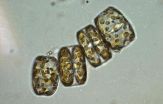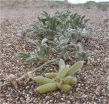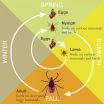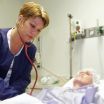It's called the "biological pump," and if it operated 100 percent efficiently, nearly every atom of carbon drawn into the ocean would be converted to organic carbon, sink into the deep ocean, and remain sequestered from the atmosphere for millennia. But like hail stones that melt before reaching the ground, some carbon never makes it to the deep ocean, allowing CO2 to leak back into the upper ocean and ultimately exchange with the atmosphere.
In a new study published April 27 in the Proceedings of the National Academy of Sciences, scientists at Woods Hole Oceanographic Institution (WHOI) and their colleague from Rutgers University discovered a surprising new short-circuit to the biological pump. They found that sinking particles of stressed and dying phytoplankton release chemicals that have a jolting, steroid-like effect on marine bacteria feeding on the particles. The chemicals juice up the bacteria's metabolism causing them to more rapidly convert organic carbon in the particles back into CO2 before they can sink to the deep ocean.
"We think these compounds are acting as signals to the bacterial community to let them know phytoplankton are dying, lots of 'free' food on the way, and to ramp up their metabolisms," said Bethanie Edwards, lead author of the study and a graduate student in the MIT/WHOI Joint Program in Oceanography. "When the bacteria consume phytoplankton faster, more CO2 is given off in the shallow depths, where it can return to the surface of the ocean and the atmosphere more quickly."
Typically, the detritus of phytoplankton have no special effect on bacteria; they are simply a food source. But the phytoplankton in this study--diatoms--are different. When stressed, some diatoms release bioactive molecules known as polyunsaturated aldehydes (PUAs). The researchers found that these molecules kick the bacteria's metabolism and CO2 respiration rates into hyperdrive -- like skinny weightlifters after a steroid shot. The bacteria start devouring the falling particles like they are at an all-you-can-eat buffet, and significantly reduce the amount of sinking detritus while releasing CO2.
Edwards, her advisor, WHOI scientist Ben Van Mooy, and co-author Kay Bidle from Rutgers University went to sea to collect and analyze particle samples from several locations across the North Atlantic, including the Sargasso Sea, the subarctic North Atlantic near Iceland, and the western North Atlantic near Massachusetts. The spatial coverage was important, Van Mooy said.
"We know that there's more sinking carbon in some places and less in others, so we wanted to better understand the distribution across different ocean regions," he said.
To collect the particles, 6-foot-wide, funnel-shaped sediment traps were submerged 150 meters down (picture huge traffic cones dunked upside down in the ocean) for 24 hours. Once the traps were brought back to surface, the scientists incubated collected particles with PUAs and analyzed changes in bacterial metabolism over a 24-hour period.
"Very rarely do you see organisms respond positively to PUAs. In fact, in higher concentrations, they often have a toxic effect, causing a decrease in phytoplankton growth rates and mutations," Edwards said. "But our results were very surprising. We saw an increase in CO2 production rates, enzyme activity, and bacterial cell growth."
The scientists also found much higher concentrations of PUAs within the sinking particles than had been previously been observed in the water column. "This suggests that sinking particles are 'hotspots' for PUA production," Edwards said.
"This study shows that when it comes to long-term biological sequestration of atmospheric carbon dioxide in the ocean, not all species of phytoplankton are created equal," said Don Rice, program director for the National Science Foundation (NSF)'s Chemical Oceanography Program, which partially funded the research.
"These scientists have uncovered yet another nuance that may affect the efficiency of the biological pump to remove carbon from surface waters," added David Garrison, program director for NSF's Biological Oceanography Program, which also contributed funds for the project.
Small compounds, big implications
Scientists investigating what controls the fate of carbon in the ocean have explored factors such as how easily phytoplankton particles break down, how much carbon they contain, and how fast they sink. According to Van Mooy, this research is the first to show how molecular compounds affect what happens to CO2 in the ocean.
"The depth of organic carbon sinking is important, as about a quarter of CO2 from burning fossil fuels ends up in the deep ocean because of these mechanisms," said Van Mooy. "For over half a century people have been trying to understand why carbon sinks more here and less there. These molecules [PUAs] are telling us they have a role to play in all this."
"We typically think of temperature and other physiochemical factors as being critically important in determining the bacterial processing of diatom detritus and how deep it sinks in the ocean, but this work shows that the molecular composition of 'infochemicals' really matters," said Bidle.
"The team makes a strong case that the growth of microbes and the consequent flow of carbon in the sea can be influenced not only by predation and nutrient limitation, but also by unique chemicals that have an effect on microbial behavior -- an important new idea for the field," said Jon Kaye, program director of the Marine Microbiology Initiative at the Gordon and Betty Moore Foundation, the study's major funder.
Edwards sees the research as a steppingstone toward a clearer understanding of CO2 absorption in the ocean and the efficiency of the biological pump in the vast planetary cycle that circulates carbon through air, land, ocean, and living things.
"By gaining more detailed knowledge about the intricate interactions of marine microbes," she said, "we can paint a more complete picture of how the carbon cycle works, the positive and negative feedbacks, and the implications for global climate."
INFORMATION:
The research was funded by the Gordon and Betty Moore Foundation Grant 3301, with additional support from the National Science Foundation and the Office of Naval Research.
The Woods Hole Oceanographic Institution is a private, non-profit organization on Cape Cod, Mass., dedicated to marine research, engineering, and higher education. Established in 1930 on a recommendation from the National Academy of Sciences, its primary mission is to understand the ocean and its interaction with the Earth as a whole, and to communicate a basic understanding of the ocean's role in the changing global environment. For more information, please visit http://www.whoi.edu.





